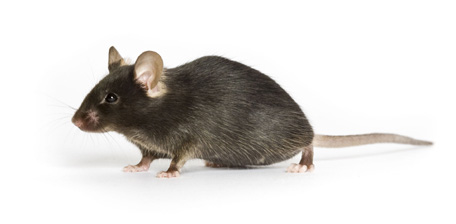Alcoholism and anxiety disorders, such as post-traumatic stress disorder (PTSD), are some of the most common neuropsychiatric disorders. Although both disorders often occur in the same individuals, little is known about the relationship between the two. By exposing C57BL/6J mice (000664) to an alcohol consumption/withdrawal regimen that mimics human alcoholism, NIH researchers led by Andrew Holmes, Ph.D., demonstrated that alcoholism may make people more susceptible to trauma-related anxiety disorders by disrupting neural circuits of fear extinction (Holmes et al. 2012). These neural circuits may be important targets for treating anxiety disorders.
Fear extinction and NMDA receptors
Fear extinction is a psychological term used to describe our ability to learn not to be afraid of things or situations that remind us of past traumas. The dysregulation of this ability appears to be at the root of fear- and anxiety-related disorders, such as phobias and PTSD, in which inhibition of fear is absent or insufficient in situations that are patently safe (Myers and Davis 2007). Fear extinction is mediated by a part of the brain called the medial prefrontal cortex (mPFC). In rodents, acute and chronic alcohol consumption appears to dysregulate fear extinction by disrupting the mPFC – in particular, its N-methyl-D-aspartate (NMDA) receptors and downstream signaling pathways. NMDA is a selective agonist that binds only to NMDA receptors, the predominant molecular regulators of synaptic plasticity and memory function. Alcoholics also have mPFC-mediated function deficits, and these may increase their risk of persistent fear after psychological trauma, as seen in PTSD.
Simulated alcoholism impairs fear extinction in mice
Although a relationship between alcohol and fear had long been evident, its precise nature and the mechanism by which alcohol degrades fear extinction had not been established. To shed light on the subject, the Holmes team subjected B6J mice to chronic intermittent ethanol (CIE) – an alcohol consumption/withdrawal regimen that mimics the heavy alcohol abuse and withdrawal characteristic of human alcoholism. They found that CIE in these mice
- Impairs fear extinction to a shock-associated auditory stimulus;
- Remodels dendrites in mPFC neurons, as evidenced by prelimbic cortex hypertrophy;
- Blunts extinction-related neuronal encoding in mPFC neurons;
- Reduces conditioned burst activity during the retrieval or fear extinction;
- Downregulates burst-mediating NMDA GluN1 receptors.
 C57BL/6J is the most widely used inbred mouse strain. It is commonly used as a background strain for congenics and transgenics and for a wide variety of cardiovascular, developmental, diabetes and obesity, genetics, immunology, neurobiology and sensorineural research. Its predilection for alcohol and morphine make it particularly suitable for studies of drug addiction.
C57BL/6J is the most widely used inbred mouse strain. It is commonly used as a background strain for congenics and transgenics and for a wide variety of cardiovascular, developmental, diabetes and obesity, genetics, immunology, neurobiology and sensorineural research. Its predilection for alcohol and morphine make it particularly suitable for studies of drug addiction.
In summary, the findings by the Holmes team suggest that alcoholism downregulates mPFC NMDA receptors and concomitantly remodels dendritic morphology and neuronal encoding of fear extinction. Chronic alcoholism may therefore increase the risk of anxiety disorders such as PTSD by degrading mPFC-mediated fear extinction. The neurological pathways involved in fear extinction may be important molecular targets for treating fear and anxiety disorders.